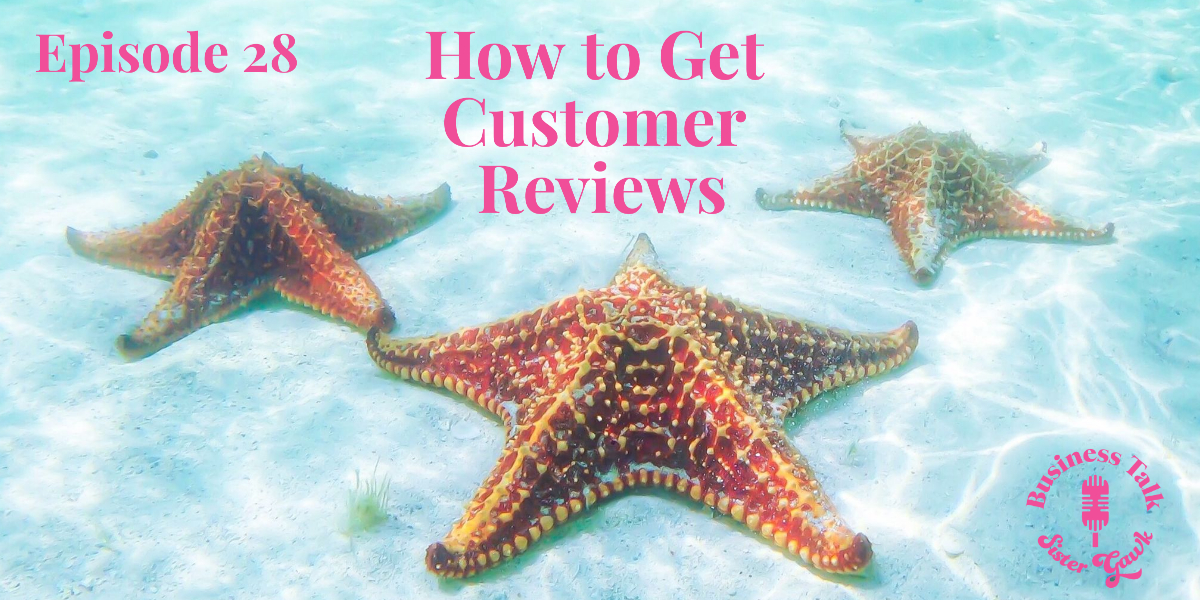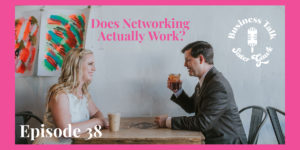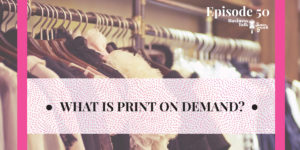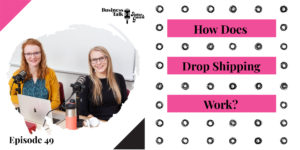In this episode, we talk about the different ways to get customer reviews for your business. From sending an email or text message, to postcard responses. We discuss the different methods you can use, and why you would go about using them for your business.
Bekkah: Today we are going to talking about how to get customer reviews. I’m super excited about this topic because Ruthie happens to be a wealth of knowledge about customer reviews.
Ruthie: That’s a bit of an overstatement.
What Should You Ask in a Customer Review Request?
Bekkah: Well, we actually both have some experience with it. What kind of questions should you ask when you want to get a customer review?
Ruthie: Basically, the general gist of it is that you want to be asking questions that you actually want to know the answer to. Instead of asking, “What was your experience like.” Ask specific questions. If you’re selling a specific product then ask about what their general review is of that product or what do you a specific functionality with that product. What they liked, what they didn’t like, and think about the way that you can craft different questions based on what you actually want to know. Maybe you really want to know if this is a good price point for your customers or something like that.
Think of ways that you can craft different questions surrounding that and then also making sure that your mixing up the kind of questions you’re asking; Open-ended questions and close close-ended questions. You can do some yes or no’s. You can do some once more long-answer, but you should really start your questions off with some that are easy to respond to. You could start off with the more simple questions and then move into the more complex ones. That also leads to another question that we had which is what kind of form should they fill out or, basically, how can you mine those responses.
How to Collect Customer Reviews
Bekkah: Ooh! How do you mine those responses? I’m curious what you’re looking for exactly in that? How do you capture those little nuggets of information that are really valuable?
Ruthie: There are a couple of different ways you can go about doing that. You can use email if you have a call with them or something like that then you can send them an email afterward. If you have their information after they’ve purchased a product on your website or maybe they’re just like a recurring customer and you already have the contact information and you already know what their email address is you can just shoot them a quick email. You could add questions in that email and say, “Please respond to the following questions.” And they can just respond to it or you could have specific forms.
I know we’ve talked about before utilizing google forms or another way that you could do it that would be more public is to have links to things like your google my business listing or your Facebook or things like that where people can leave reviews more publicly. You could also do that if you’re selling on Amazon. You can ask people to leave you a review there. There are lots of different ways that you can get reviews from people or get different customer feedback. I’m thinking about this more in terms of just feedback from your clients, whether that’s to be seen by the rest of the world or just internally, and how you use that to make your business better.
Bekkah: I think it’s important to note that customer reviews when people talk about them today they’re usually talking about on their Facebook page they have tons of reviews or on their Amazon listing there are lots of reviews there or whatever. But when you’re talking about internal reviews as well you’re trying to see if commonly when people get off the phone they say, “Please stay till the end till you hear this short survey, and tell them that I was awesome because that’s how I get paid.” That’s more of an internal review to find out did that person do their job. Two different categories of what you would use the reviews for and where those are posted.
One of the things that we wanted to make sure that we covered is a lot of times, the way Ruthie is suggesting it is by asking specific questions about the product and all of that because then you can get some specific customer quotes like, “This was so helpful for me it solved all my problems.” Great that’s a great customer quote to use in your marketing, advertising, or what our customers are saying. Yes or no questions – was this product helpful for you, “Yes. Then you can say, “90% of our customers find our product helpful.” Which is awesome.
Ruthie: Super vague!
Bekkah: I mean make it very specific I’m just being broad right now. I mean come on some people do that. Peanut butter! Prime example!
Ruthie: What?
Bekkah: Choosy moms choose Jif! What the heck is a “choosy mom”? What do they go around are you a choosy mom?
Ruthie: That’s basically their whole intake form. are you a choosy mom? Yes or no?
Bekkah: Anyways, that’s beside the point. Some people do that. I wouldn’t necessarily recommend it. Unless you’re going to make it part of a ridiculous slogan like Jif did then I mean go for it.
Ruthie: It’s memorable. You remembered it.
Bekkah: Anyways all right so when we’re talking about asking for those customer reviews and you’re finding out maybe their review was less than pleasant. Having an intake form like Ruthie is talking about is a really good way to do that. She mentioned like doing a Google form whatever. There are a lot of programs that you can actually do “if-then” statements as well. Oh my goodness! I just learned so much about all of these cool ways you can do that! One that I’ve seen used a lot for specifically reviews is a review platform called Broadly.
How to Use Broadly to Manage Good and Bad Reviews
They do a really good job of sending emails and then you ask questions like, “Was this great experience or not so great?” If it’s not so great it kicks it back to a form where they can get information sent over to the manager to say, “Hey, there’s an issue.” And if it was great then it just pushes them directly to leave a review on like Yelp or your Google business listing or your Facebook page. It’s pretty cool but there are also other ways you can build those functions for pretty inexpensively on your own. I just read this really cool article about how people are using “if-then” statements for text message ordering. It was really cool. I’ll share the article.
What Is an “If-Then” Statement?
Ruthie: Explain what an “if-then” statement is.
Bekkah: If you’re programming something on your own in the back end to say, “If someone responds this, then you should respond to this.” Very similar to, actually, exactly how chatbots work. What I just found out within Facebook, fun opportunity here, you guys, so you should totally check it out! When customers ask you questions and you respond, Facebook now has this really cool tool that says, “Would you like to save this response for later?” When a customer asks a similar question.
Basically, it’s categ – er, cataloging. I was going to say “categaloging”! That’s not a word! Categorizing and cataloging at the same time. It’s categorizing those things, storing them for you for later, so that it can be almost as efficient if not already into a chatbot. When someone in the future says, “Can you get me pricing on this?” It’s like, “Boom! Here’s the answer right there.” It’s almost like the auto-suggest feature that Google has when you’re typing an email.
Ruthie: So it saves the responses that you’ve sent to people?
Bekkah: Yes! In the Facebook messages from your business page.
Ruthie: Wow!
How to Use Facebook’s AI Chatbot
Bekkah: Oh yeah! I have so been experimenting! I love it! Oh my goodness! I was so excited! So if your customers are actually sending you Facebook messages, definitely check out that feature because it’s a new thing that Facebook is rolling out and it could be really helpful for documenting that stuff in the future. I haven’t looked into it but there might be a way to export those.
Ruthie: Ooo! You can use it for other channels of marketing, too? That would be really cool!
Bekkah: I don’t know if that’s an accurate statement yet, but it would be so cool if they did!
Ruthie: If they don’t, copy and paste it get a little more creative. Put some elbow grease in there. Get it done.
Bekkah: You can do it on your own. That’s also really helpful when you put someone else in charge of getting your customer reviews because then you don’t have to do it all yourself and the questions already built up. When we’re asking for in an email or a text message you can send them a direct link to the page that you want them to review. You should probably ask a couple of questions first like Ruthie said, “Hey, how was your experience with us?” And if they’re like, “Yeah it was great!” Then you’re like, “Awesome! Here’s the link to this form. Could you say that publicly?” That’s a great way to do it.
How Soon Should You Reach Out to Get a Review?
When should you follow up, Ruthie? When you have a customer and you want them to give you a review because you know you did everything above and beyond what does that timeline look like?
Ruthie: It depends on your business model. Whether it’s product base or service base, but also the typical longevity of how long someone uses your product. If it’s something where you’re just providing food for someone and they eat it. You’re going to want to follow up with them right away, but if it’s something where you have this product that maybe it’s like a toilet cleaner or something like that or you know one of those drain snakes or something where people won’t necessarily – maybe somebody would use that right away, actually!
Bekkah: I bought that because I had a problem!
Ruthie: But when it’s something that might take a little bit longer for them to decide if they like it, maybe let’s say like a pair of shoes or something. Then that’s something where you could wait a little bit until they get used to it. Wait until they fall in love with it and then you reach out to them in a timely manner and say, “Hey, remember us? We’re reaching out to you?” That’s the important thing is you want to reach out and say something personal. Explain to them why you know them. Like, “You recently purchased this from us,” or “We recently re-did the gardening in your front yard.”
Explain why you know them and then from there get into more why you’re reaching out to them. Then from there, you can ask your questions and things like that. Explain why they answering it will benefit you. You kind of have to know your target audience as well to know what kind of response you’ll get. If you’re wanting to get in contact with someone who you know they don’t have a lot of time they’re just very “We’re doing it quick” You want to just say those things and make the questions as short as possible. Make them very like to the point. Be precise with your language. No fluff. Avoid that. If there’s someone like, I know we talk about librarians all the time but people who you know are going to be more like long-winded in some way.
Bekkah: You’re saying librarians are long-winded?
Ruthie: Well, articulate. Maybe that would be a better way of putting it.
Bekkah: They just like words! Like us!
Ruthie: But maybe you have a product for moms or something like that and you know that maybe they’re going to put more time into it. Then make it in a way that is a little more flowery, a little bit more personal. Know your target audience and know how to word the questions. Then in that, that’s kind of the flow that you want in your emails to them or in your text messages to them. Tell them why you’re reaching out to them. Tell them what the purpose is and that it will benefit you. Maybe it’ll benefit them in the long run and then ask your questions.
Utilize Handwritten Thank You Cards
Bekkah: Okay another really cool thing that we didn’t really talk about but I think this is amazing because a lot of older businesses do this and when they do I kid you not, I sit there when I’m waiting at the office or whatever and I read them. When people actually write handwritten thank you cards to a business and they’re like, “You guys were amazing.” And then they pin those up on their bulletin board! I legitimately read those while I am in their business because I’m like, “Oh! What do they buy?”
I learned this tip from somebody who is significantly older than me, a lot wiser, and pretty cool. Basically, this guy was talking about specifically was that he created a postcard that had, “How was your experience with us and what could we have done to make it better?” And asked all these different questions. So he had a postcard, right? Then before he was leaving the interaction, he pulls the postcard out and says, “Hey, if you could take the time to let us know how we did today that would be really wonderful.” Then he reaches in his pocket and pulls out a postcard stamp and puts the stamp on the postcard in front of them. Do you want to know something? He said that when that happened, the whole taking the stamp out of the pocket, and putting it on the postcard!
Ruthie: Nice and slow!
Bekkah: No, seriously! It was like, “I’m committing like what is it like 20 cents? To this, so that you will respond.” It increased their postcard mail-back rate by like 80%
Ruthie: Wow!
Bekkah: It was incredible! Because people are like, “Whoa! You just literally put a stamp on that! Now I gotta mail it! Like I’m invested!” When you get those back you get to post them up in your business! That’s really cool!
Ruthie: You could post them on your website, too!
Bekkah: You can take pictures of them and post them in your google photos. There are lots of ways you can do that. Sorry, side tangent but I was just like, “This is Amazing! The man is a psychologist! This is amazing!
What to do With Customer Reviews
Ruthie: Bekkah, tell us what you should do with the reviews after you receive them. You’ve got this valuable feedback from customers. Now what?
Bekkah: Okay so if you get great reviews. That’s awesome. You should be responding to them. If somebody’s commenting on your Facebook or your google business page, first of all, you should have claimed those things.
Especially, the google business listing. Then you should respond to those things. If someone says, “I had a really great time with this person! blah, blah, blah” Say, “Wow! Thanks so much for saying that! We really appreciate your business!” And if you have a personal note that you wanted to make on there to that person, do that. Not necessarily like super like, “And say ‘hi’ to your wife.”
Ruthie: “From me and the boys! Hope you’re doing well.” t
Bekkah: Don’t get all grandma-y, but you know. Definitely thank them publicly for those reviews. Sometimes people will comment back like even more stuff about their experience and you’re like, “Wow! This is like a really long lovefest! I love this!
Ruthie: Oh! And, and we’re going! We’re still going!
Bekkah: But definitely keep that positivity going on. Who should you be reaching out to, Ruthie?
Ruthie: Keep in mind when you are, like Bekkah was talking about with Broadly, if someone says that they have a negative experience you’re going to want to have a system set up to respond to negative people. Or someone who has had a negative experience with you, maybe not negative people. That’s probably not the best way to word that. You should have a separate process that you go through. If you just have one email template that every time says, “Thanks so much for your review!” It’s like, “Okay, but they had a horrible experience.” Have a way that you can reach out to them.
One thing that I saw that I thought was really cool was when someone had an abandoned cart. If they put a bunch of stuff in there and then didn’t buy it, they would get an email like a week later saying, “What could we have done to make you submit your order?” Then that gives them the opportunity to say, “If you would have had more discounts. If you would have sold this specific brand.” Or something like that so you’re still getting that feedback from them in a way that can actually enhance the experience for them.
As far as who you should be reaching out to, the people who’ve had good experiences and the people who’ve had bad experiences and know the age demographic of the people who you’re servicing. Obviously, you should be reaching out to people who are like not children. Know the age range of the people that you’re needing to get the reviews back from
Bekkah: Okay but here’s the thing. When you’re like, “What could we have done better?” If they respond you need to solve the problem. It’s not just like, “Oh, we’ll add that support ticket to the list, thanks!”
Ruthie: “And never get back to you.”
Make Content Based on Reviews to Help Future Customers
Bekkah: I think, even in some of the software stuff that I’ve tried somebody’s like, “Why didn’t you use this anymore?” And I responded, “Well, quite honestly because the software was not intuitive and it kept not working for me.” And they responded, “I’m so sorry you had that experience. We could definitely set you up with a customer representative to walk you through that.” I’m like, “I do not have the time for that.” But if you specifically hone in on what was the functionality that was broken I would probably respond and say this was what wasn’t working.
There was no guided tour to show me how to use this correctly or whatever. Then boom! That’s the content you should be making as a youtube video or whatever and then sending it back! And saying, “Here’s that video! So sorry you didn’t have a great experience but we went out of the way to make some content for that so in the future people won’t have this problem.” Regardless of if I had that experience that was positive or not, it’s going to help the next person so that your product is better and people will like it more.
Ruthie: That is our episode for this week! Next week we will be discussing how to pay off your student loans! So don’t miss that one. It’s going to be really good and we’re going to talk about some personal experiences with that!




